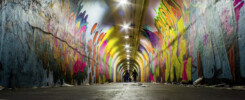With the transformation of contemporary thought
and art until after the millennium the field of plastic photography is witnessing a clear change, especially with the emergence of
Graffiti art as one of the visual languages associated with street art, which has emerged with non-traditional concepts in subject matter, style and tools since The eighties of the last century, and it gained fame until it became one of the finest arts after it was marginalized and unrecognized. Art contributed
Graffiti in revealing the possibilities and contents of satirical criticism raises issues of society in addition to aesthetics and symbolic connotations that carry
New visions and open the way for artistic practices keeping pace with all changes.
And with the “increasing artistic movement in Saudi Arabia in the new millennium, and the opportunities for friction and external exhibition, it contributed to the presence of a large number of
Among the artists with their works of a contemporary nature, which deviated from the traditional formulas that prevailed until the mid-nineties of the century
In the twentieth century, and with the continued influence of the awakening, the Saudi artist turned to works that depend on ready-made forms or installations
space, photography, or films, so she avoided the problems of analysis and prohibition, but at the same time was able to express herself with a space of freedom.
On the political topics that were absent in the works of the Saudi artist previously, he also expressed social problems without a direct confrontation with the
society or the legislator” (Al-Senan, 60, 2018).
Seeing the artistic action on the street walls in Saudi cities as a means of expression in words and simple caricatures.
It is a shift in the form of a clear artistic practice after the introduction of the Internet to the Kingdom and the spread of the term (street art) globally, which created a ground
Open to interaction and exchange of experiences, work tools and ways of using them in circles passionate about talent and art, as this global integration
Making the youth and adolescent groups the majority in the tendency to adopt the contemporary artistic mood, this was done unintentionally, destabilizing what could be
Call it “the monopoly of artistic value.” Especially since, for at least half a century, it has been determined almost exclusively through an institutional lens, the artist
He is someone who is recognized as an artist by a legally qualified institution, and the same applies to the artwork that they value on this basis, and not in an essential aspect related to the work. The cultural or social institution
Or the private ones that we invite him to paint on the sidelines of cultural events or to decorate commercial centers and shops, which gives him a kind of recognition of his being
Artist, and the same effect does not occur in those who offer the same practice without paid or unpaid invitations. Anyway, the street artist benefits
from this confession; As sometimes these paintings arise mainly as a means of advertising the artist’s talent, which is what created a kind of new profession in art
talent square. Not least is the recurring appearance of celebrity brands and spray paint shops in street art


